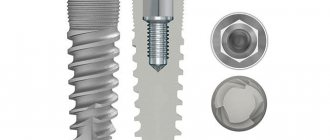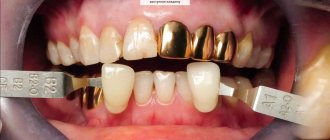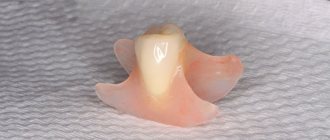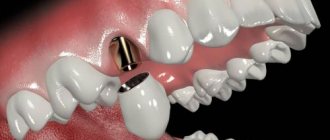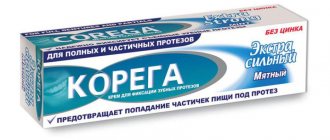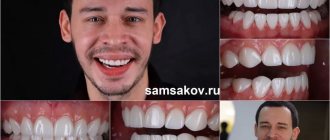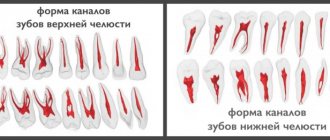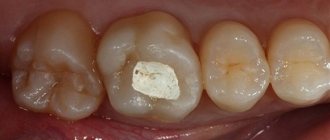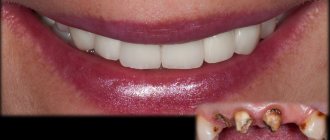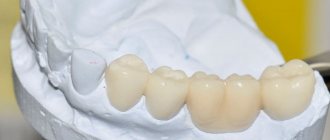Pros of ceramics
Engineers and chemists of large concerns for the production of dental materials (mostly German) are very hardworking and purposeful people. This is not a common stamp - I was convinced of this from my own experience, watching the evolution of ceramic crowns from Ivoclar Vivadent for 15 years. This is not an advertisement - this name means little to the average person, and dentists do not trust advertising. Over the years, the company has come a long way from really fragile crowns in the 2000s (the instructions said so - only for front teeth, with a bunch of contraindications) to the modern material e.Max (Imax, emphasis on the letter I), which in most cases regions is crowding out the former grandee - zirconium dioxide.
Let's list what makes Emax so remarkable:
- Strength. Allows you to make not only crowns, but also bridges. Not only for front teeth, but for any teeth. There is enough strength to spare.
- A huge selection of colors, transparency options , the possibility of individualization either by simple painting or by applying additional layers of ceramics (this is the finest work on the verge of craft and art, in some cases up to 15 layers of ceramics are used, achieving incredible naturalness).
- Possibility of manufacturing individual implant abutments. The abutment is the outer part of the implant; the crown rests on it. There are two options for their use - standard titanium abutments manufactured at the factory (there is no time for aesthetics here, the strength or complexity of the design is important) or individual abutments. If you make such an abutment from Imax material, the crown on the implant (by the way, it can also be Imax) will be more aesthetically pleasing.
- Emax has brought digital technology directly to the dental chair. Now the doctor can make crowns on his own and in one visit . The aesthetics and strength are the same, the accuracy is higher - the human factor is reduced to a minimum. This technology is called CEREC (Cerek, emphasis on the first syllable), in conjunction with modern ceramic materials, it is incredibly convenient for both the doctor and the patient.
- The crown is bonded to the tooth (dentists call this bonding) by creating a chemical bond between the ceramic, adhesive luting cement and the tooth tissue. This connection is absolutely sealed and durable.
What to make a tooth crown from so that it lasts as long as possible
Does the material used to make a crown affect the longevity of a tooth? Theoretically, of course, yes, the material can affect the service life of the dental crown. Let's find out why.
The first factor in service life is the thickness of the dental crown.
Let's consider the case if the usual classic metal ceramics are installed, under which it is necessary to depulp the tooth. In most cases, due to the fact that the metal layer (the thickness of the metal frame) can be at least 0.3-0.4 mm, the ceramic layer is 0.8 mm, then in the most “unaesthetic”, but most gentle for the patient, scenario, The thickness of the dental crown will be 1.1 mm and, accordingly, the tooth will have less tissue left. It is necessary to draw your attention to the fact that the tooth is pulpless and, of course, this is not very good for it, since the tooth will need to be ground down more actively for a crown:
And this is ideal; in fact, the wall thickness is even greater, and the ceramic layer can be at least 0.8 mm.
The second factor in the service life of a crown is the quality of the material.
The quality of ceramics also implies, in most cases, its cost. Many patients take risks when trying to find ceramics at a low price. Ceramics are different from ceramics. You need to clearly understand that chipping of ceramics can occur if it is not of sufficient quality.
Ceramic chips
cannot be repaired in the oral cavity, it is necessary to remove the crown from the tooth and make a new one. But, of course, each time removing a crown and making a new one is unlikely to have a positive effect on both the patient’s mood and the condition of his tooth. However, “pulling” the crown back and forth because you once decided to save money is not entirely correct, you will agree. Poor-quality ceramics will not bring much happiness to the tooth.
At the same time, modern ceramics - those that, so to speak, have increased strength and can be used even without frames, for example, E-max ceramics, with a minimum thickness, have a strength almost comparable to conventional metal-ceramics. Accordingly, the prosthetic tooth retains more of its tissues. In this case, the metal-free crown is fixed with special cements, from which it is almost impossible to remove this crown. In essence, an all-ceramic crown is its own, new restored tooth enamel, but ceramic.
CONCLUSION:
Of course, with such strength of ceramics and its minimal thickness, the tooth’s own tissues are preserved to a greater extent, so we can say that in this case the material affects durability in 100% of cases.
Now let's talk about the next important factor
, affecting the durability of the crown.
Will the crown sit firmly on your tooth or will it have to be removed. So this is the human factor
.
Which teeth are crowns placed on during prosthetics?
Today, the question “which teeth are crowned on” refers less to their location on the upper or lower jaw, but to the condition of the teeth themselves. If you need to remove the defect of only one tooth, on which a crown is installed for this purpose, then its condition can be initially any. But before it comes to making a crown, the tooth requires basic treatment. If a patient develops processes such as periodontitis, then first the doctor must go through all the canals and seal them using gutta-percha pins and filling material. The quality of root filling should be checked using an x-ray. If a cyst is found near the roots, then this is not always a reason to remove the tooth, but it requires longer treatment, the prescription of antibiotics and other drugs that help restore damaged soft tissue.
If the visible part of the tooth is completely destroyed, then the crown can be installed on the root using a dental inlay. If it comes down to tooth extraction, and the person agrees to implantation, then in this case, too, a crown is used, which “crowns” the implant, imitating the visible part of the tooth. But where to put the crowns, on the upper and lower teeth, it doesn’t matter. Even if it is necessary to properly heal wisdom teeth that a person chews normally, dental crowns can be installed.
Features of crowns on implants
During implantation, the entire tooth is made anew: both the part that replaces the root and the visible part. The types of crowns for implanted teeth are as follows:
- ceramic;
- zirconium.
The abutment for ceramic crowns is often made of zirconium dioxide so that dark metal does not show through the ceramic. If a chewing tooth is implanted, the crown can be made of zirconium dioxide, and the abutment can be made of metal. However, this design is also suitable for the smile area, if the patient is not very capricious or is somewhat strapped for finances. Dental crowns on implants can be chosen not only by aesthetics, but also by cost. And since the price of dental crowns varies greatly, you can choose the option that will be quite affordable for you. It is not necessary to install dental crowns made of metal-free ceramics! It will be easier to determine which dental crowns are best if you know what your budget will be. Therefore, you should try to make a preliminary calculation together with your doctor.
Omerelli Emir Romanovich
Specialization: maxillofacial surgeon, implantologist Work experience: more than 13 years Place of work: Works at the RUTT clinic on Proletarskaya First category doctor.
Candidate of Medical Sciences. He was one of the first to use the method of single-phase dental implantation with instant loading in Russia. He is a member of the Open Dental Community (ODC), where he took part in the development of the ROOTT implant system.
Every day he performs operations on classical dental implantation and implantation with immediate loading for complete and partial edentia.
Wearing period
There is no point in wearing temporary crowns for a long time; they are usually used until the time comes to install permanent structures. On average, this is no more than two weeks, but in complex cases it may take a little longer. In any case, the attending physician will definitely orient his patient regarding the timing of treatment.
Of course, if desired, the patient can wear temporary dentures for several months. But over time, chips may appear on them, and they may change the original shade. A temporary crown helps to quickly get used to a permanent prosthesis; as a result, a person does not feel discomfort and practically does not feel the presence of a foreign object in the mouth.
The cost of such crowns will largely depend on the material used by the master, as well as on the manufacturing method. The direct method allows for significant savings; ready-made dentures also cost less. In this case, you will have to choose: high quality and aesthetic component or low cost.
Caring for metal and ceramic crowns
Metal ceramics do not require special care. Enough:
- brush your teeth regularly to remove food debris;
- rinse with rinses (for example, “One Drop Only”, “Paro Chlorhexidine 0.12%”), intended for daily care for gingivitis, periodontitis, stomatitis, as well as after surgical operations on the oral mucosa;
- rinse with warm decoctions of herbs (for example, chamomile, lemon balm, rosemary, sage, bloodroot, witch hazel), which reduce bleeding gums.
To care for the crown, it is better to purchase a toothbrush specially designed for people with implants, dentures, or orthopedic structures (especially if no ledge is created during preparation). They clean the interdental spaces, gingival areas of the teeth, and the space under the crowns well. The brushes are small, the working part is usually a bundle of fibers collected into a cone, or 1 row of bundles.
Caring for metal-ceramic crowns
The most popular orthodontic toothbrushes:
- "Antiplaque". The bristle profile is V-shaped. Designed for patients with various orthodontic structures (crowns, braces).
- Oral-B Interdental. There is a removal-fixation system with a “volcano-shaped” tip, which makes it easier to replace cone-shaped or cylindrical brushes.
- "StaiNo Interdental Brush" ("Sultan"). Aluminum oxide abrasive bristles are used. The brush cleans well the interdental spaces and the space around bridges and braces. The brush designs and color markings are different.
- Lacalut Interdental. There are 2 replaceable heads for cleaning interdental spaces and effectively processing orthodontic structures and bridges. Used without toothpaste.
The dental floss recommended by dentists for cleaning a metal-ceramic crown without the risk of damaging it is Oral-B Super Floss. This is a triple thread, which includes:
- a short, rigid tip for ease of entry into the interdental space and under the body of a bridge or orthodontic structure;
- A section of soft nylon fiber (sponge floss) cleans areas around and in wide spaces between teeth;
- regular floss removes plaque in the periodontal sulcus.
Superflosses are specially designed for patients who have permanent orthopedic crowns. It is not recommended to use regular threads.
Electric toothbrushes and irrigators cannot damage a high-quality metal-ceramic crown. However, if the manufacturing technology is violated, the supply of water under pressure, as well as pulsating or reciprocating movements can lead to microcracks.
When choosing a toothpaste, you should pay attention to products that provide the prevention of caries, periodontal diseases and oral mucosa. Remember: tooth ceramics are dense, not porous. There is no point in using special whitening pastes; you can continue to use the one you are used to.
How to extend the period of use
In order for the crown to last as long as possible, it is important to minimize the level of chewing load on a particular tooth. In this case, the load should be minimal not only on one tooth, but also on the entire jaw on the side where the temporary prosthesis is installed. You should also avoid certain foods: chewing gum, toffees, chocolate, nuts, hard vegetables, etc.
It is also important to pay enough attention to oral hygiene. Brushing should be done using a soft toothbrush and not applying too much pressure. You need to use dental floss with extreme caution; you can only pull it horizontally and only at one end.
A well-made temporary crown made of plastic or composite can last up to six months. If you follow all the dentist’s recommendations, quit smoking and certain products, it will not only restore the functional properties of the dentition, but also preserve the aesthetics of your smile.
previous post
How can a dentist help me maintain dental health?
next entry
How is a crown installed?
When the choice of prosthesis is made, all that remains is to install it. Many people worry and reluctantly go to the dentist, not knowing what awaits them. To have at least some idea about a visit to the dentist, you should understand how he will install the crown.
- The installation procedure is not as fast as we would like, and definitely takes more than one day.
- First of all, you need to visit a dentist so that he can determine the extent of damage to the tooth, and whether you need a crown or not.
- After the examination, you will be sent for an X-ray to identify any defects.
- Next comes the preparatory stage for installation. If necessary, the doctor treats caries and other dental diseases. If the tooth has been completely destroyed, a permanent pin is installed in the root.
- As we already know, the crown is delivered on the filed edges of the tooth, so the next step will be grinding. This is necessary to ensure that the crown sits firmly and does not create backlash.
- After grinding, the process of making a cast of the future prosthesis begins.
- Melting the crown itself includes choosing the shade of the future “replacement” tooth.
- As soon as the crown is ready, you need to try it on to make sure that it fits you exactly and will not interfere, press or cut your gums. The denture is installed for a certain period of time.
- If temporary wear does not cause any discomfort, then the dentist fixes the prosthesis permanently using medical cement.
A crown fell out: what to do before seeing a doctor
So, the crown came off. You can’t immediately grab any technical glue you have at hand and try to glue it back. Some people make a big mistake using superglue. Its composition is very toxic and burns through living tissue. The dentist will not be able to reinstall a crown fixed in this way.
If a crown comes off, follow these recommendations.
- Wash the fallen crown with water, wrap it in a napkin and place it in a bottle or box so that it does not break before your visit to the dentist.
- Brush your teeth gently. Be careful not to damage the stump. Use rinse aid.
- Hold off on eating and drinking drinks (except water).
- Make an appointment with an orthopedic dentist as soon as possible.
- If pain occurs, take a pain reliever.
How to glue a fallen crown at home?
If it is not possible to visit the dentist in the near future, the fallen denture can be temporarily glued back. Pharmacies sell dental cement, which is used to secure a fallen-off denture.
- Mix the glue ingredients according to the instructions.
- Apply cement to the washed and dried crown.
- Put it on carefully. If the denture does not fit easily into place, do not try to force it in to avoid chipping the tooth.
- Press the crown onto the tooth with your fingers for 1 minute (without being too hard).
- Then close your teeth for 2 minutes.
- Remove remaining cement with a toothpick or dental floss.
This way you will protect the tooth stump from bacteria and damage while eating before going to the dental clinic. Avoid solid foods, brush your teeth twice a day, and use mouthwash. However, dental cement should only be used as a last resort. Don't delay your visit to the dentist.
How much does a removable denture cost for the upper jaw?
Prices
| Service | Price |
| Nylon dentures | from 34,900 rub. |
| Clasp dentures | from 48,500 rub. |
| Complete dental prosthetics on implants | from 215,000 rub. |
| All-on-6 prosthetics | from 221,000 rub. |
Interesting materials:
How much does the original glass for iPhone 11 cost? How much does an overdraft cost? How much does soldering of plastic pipes cost in Ukraine? How much does food grade aluminum cost? How much does Bud beer cost in a magnet? How much does Play with button cost? How much does it cost to clean the speaker on an iPhone? How much does it cost to clean a PS4? How much does it cost to move furniture up to the floor? How much does a gondola ride in Venice cost?
Crown materials
Temporary crowns can be made from a variety of materials depending on the patient's budget and desired result. The most commonly used materials are plastic and special composites. These materials are sufficiently durable and relatively inexpensive, which is great for short-term wear. Of course, if the patient wishes, the crown can also be ceramic, metal-ceramic, or made of durable zirconium dioxide.
A distinctive feature of plastic products is that they tend to change their original shade due to exposure to food coloring, smoking, etc. Also, plastic is not able to withstand strong pressure during chewing, as a result, chips, cracks may appear, and the crown may even fall out. Due to the porous surface, pathogenic microorganisms can penetrate into the product.
If for some reason plastic is not suitable for the patient or he is allergic to this material, then the doctor may recommend the use of a composite, for example, acrylic. Such crowns are made directly in the patient’s mouth by layer-by-layer application and fixation using a special lamp.
